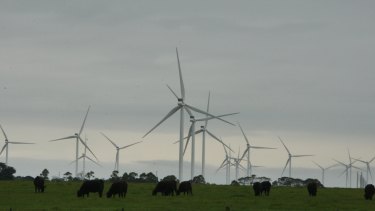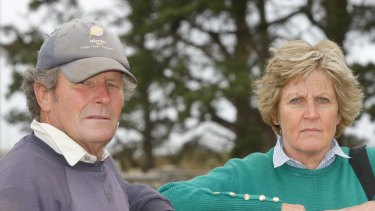In 2011 the Gardners, the sole shareholders in Marramok, won second prize in a competition run by luxury Italian menswear label Ermenegildo Zegna to find the finest and most valuable wool grown in Australia.
But they say they were inundated with dust and bombarded with noise from construction of the wind farm, including from rock crushers placed near their property, after which 260 of the sheep died and the remainder “became unable to produce ultra-fine wool”.
“The sheep were specially bred in that Ann and Gus had engaged in artificial selection of the sheep over many generations so as to produce ultra-fine wool of some of the highest quality … in the world,” their statement of claim reads.
The sheep were housed in a shed on the property, where the couple also have a home. They have been breeding the specialty sheep for more than 30 years.
“Between about 23 November 2011 and about May 2012, construction works at the site associated with the wind farm periodically caused significant quantities of dust to be emitted from the site and blow onto the land,” the statement of claim reads.
“Between about May and July 2012 … approximately 260 of Marramok’s sheep died … and the remaining sheep became unable to produce ultra-fine wool.
“Because of their special breeding, the sheep affected … could not be replaced by other sheep available on the market. Because of the adverse impacts, Marramok’s wool growing business was destroyed … and the value of shares held by Ann and Gus were diminished …

AGL’s Macarthur Wind Farm in western Victoria.Credit:Leanne Pickett/Warrnambool Standard
“AGL had a duty at common law … to take reasonable care to ensure that the dust emitted from construction works on the site did not injure the health of people or animals in the path of the dust.”
AGL knew the Gardners were operating a wool growing business on their property prior to it starting construction of the wind farm, the statement of claim says.
It was also aware of the Gardners’ concerns about dust emissions and the potential impacts on their sheep after they complained numerous times, the statement says.
The Gardners say the impact of construction was high when builders operated a rock crusher between December 13 and 20, 2011, and on March 27, 2012, and especially bad when it was used within 300 metres of their land between February 19 and March 3, 2012.
They were also affected by workers sifting dust in November 2011 and operating dump trucks on a turning pad in January 2012, their statement of claim says.
The statement documents dozens of complaints over consecutive months from the couple to AGL staff.
In response, “AGL apologised, promised that the dust would be abated and offered to pay for the Gardners’ home, furniture covers and bedding to be cleaned”.
“Once AGL received the complaints from the Gardners, AGL accepted a duty of care and admitted breach thereof, by apologising for the dust emissions, promising to mitigate them and offering to pay for cleaning,” the statement says.
However, AGL failed to abate dust emissions or tell builders to take sufficient steps to abate the dust, the Gardners say.

Gus and Ann Gardner on their property in 2012.Credit:Rob Gunstone/Warrnambool Standard
In its defence, filed by its lawyers in February, AGL admitted some allegations that dust had blown onto the Gardners’ land on occasion.
However, it denied a number of allegations, and said it had employed dust mitigation strategies, including reduced speed limits, use of water to suppress dust, use of dust monitors on the boundary of the Gardners’ property, and reducing use of machinery on windy days.
It made no admissions relating to any effect on the couple’s sheep.
“To the extent that any dust from the site permeated the shed at any stage, it does not know, and does not admit that any sheep were exposed to or ingested that dust,” the defence statement says.
“(I)f, which is denied, any dust emissions caused material injury to the sheep, that harm arose because of the abnormal sensitivity of the sheep kept by the plaintiffs.”
The 140-turbine wind farm generates enough energy to power about 173,000 homes.
AGL sold its 50 per cent stake for $532 million in September 2015 to investment firm HRL Morrison & Co.
However, it continues to maintain and operate the farm on behalf of HRL and Malakoff Corp, its other joint venture partner.
The case is expected to be heard in Warrnambool in late 2019.
Debbie Cuthbertson is a senior writer and Saturday chief of staff at The Age.
Most Viewed in National
Loading








